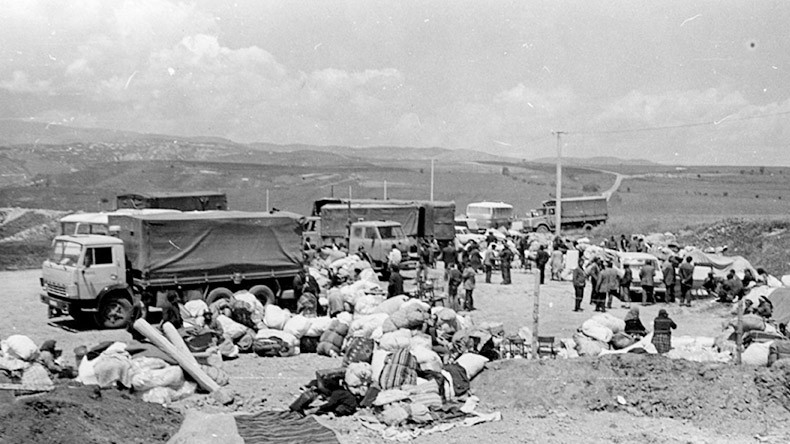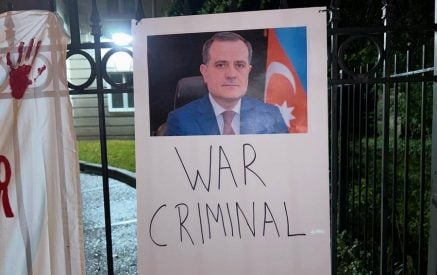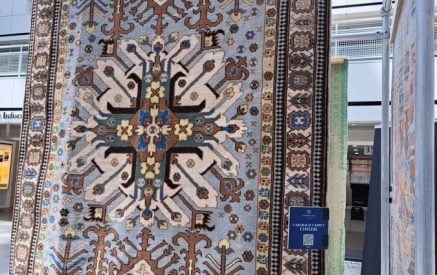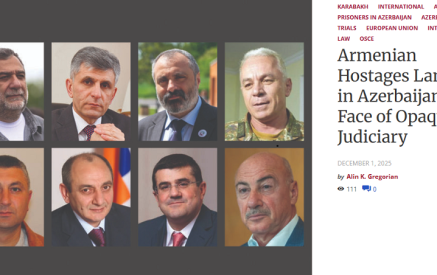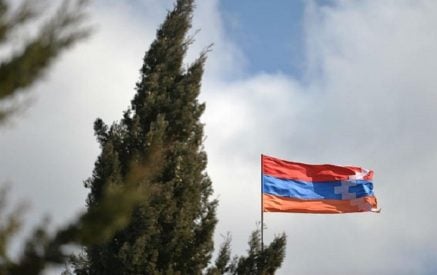To the Editor:
Would you like to interview our fighters from Shahumyan? Asked me the mamig sitting at the desk on our floor in Hotel Armenia.
Read also
‘Shahumyan?” “Where is Shahumyan?” I asked her. “You don’t know? They will tell you all about it. Let me call them to come,” she said without waiting for my reply.
It was March 1990. I was in Armenia as guests invited to celebrate International Women’s Day and to observe first hand and report back to the community on the December 1988 devastating earthquake in Armenia.
My two colleagues and I exuberant but with some reservation flew to Yerevan. Although I had been there before, I knew this time would be different. The 1988 earthquake in Armenia and the pogroms against the Armenians in Baku and Sumgait in Azerbaijan during the same year and the resulting refugee crisis had shaken the whole Armenian world. We did not know what we would encounter.
It was three o’clock in the morning when we arrived at the Marriott — then known as Hotel Armenia — in the center of Yerevan.
My lodging was a small, dimly-lit but neat single bedroom in the second building at the back of the main hotel, overlooking some construction across the road.
We spent the next day with our hosts who took us to Gyumri (Leninakan) and Spitak where the earthquake had struck. The scenes were catastrophic and our mood was somber as we strode back into the hotel lobby that evening for dinner.
Suddenly a great commotion took place. A group of ten or twelve men dressed in khaki uniforms hastily entered the hotel and headed towards the dining room across from where we were standing. A few minutes later the loud music that was playing there instantly stopped. The men came out and headed back to their car parked outside. All the bystanders in the lobby were startled. What was happening?
The uniformed men obliged and told us that two young border guards were shot dead during skirmishes on the border with Azerbaijan. They were going to bring their bodies to the Opera square In Yerevan the next day.
The hotel lobby went quiet. We were all alarmed. The people in the dining room started exiting the hall. We were totally unprepared for this. We were speechless. Fear overwhelmed us. What is going on? What on earth is happening?
Gathering our strength, we decided to go to the Opera Square the next day.

Sylvia Iskenderian
In the morning one of my colleagues ,the late Alice Levonian and I walked to Opera Square carrying my hefty video camera. The square was already packed with people. We felt we had arrived too late, and that we had no chance to see anything up close. However, before we could decide what to do, a crack opened up in the crowd, everyone pushed aside and urged us to go forward. We were ushered through the masses and the people promptly helped us on to a platform on the side of the Statue of Alexander Spendiaryan in the middle of the square! We realized then, that as the public noticed a video camera in our hands they wanted to make sure that the whole thing is recorded for the outside world to see.
A crowd 100,000-strong had gathered at the square that morning, mourning the death of those two young soldiers.
Our hearts heavy and overcome by emotions we returned to our hotel. The mamig whose job was to check on the hotel guests, asked if we would like to interview the Shahumyantzi’s.
We were not journalists. We were three ladies from far away Australia who happened to be in Armenia to take some notes about the earthquake. We had little knowledge of Karabakh and knew nothing about Shahumyan.
We were taken by surprise. Where was Shahumyan anyway? Having witnessed the previous day’s events and the heart wrenching funeral on the day, we accepted the challenge. It seemed our video camera was doing a great job.
Promptly we were in my room frantically setting up an ad-hoc interview room. Alice had the job of holding the camera and Silva Kebourian, my other colleague, held the makeshift light we borrowed from the mamig who obliged and brought it from the store room.
We certainly did not have time to prepare questions.
Instantly, two well-dressed gentlemen with grim faces showed up at the door. They came in and sat down.
We need not have worried about the questions to ask, as soon as we started the video running, they started telling us their story.
We heard what had happened and how it all had begun. The Azeri Omon forces, without any warning, had raided the Shahumyan Council Chambers in January of that year and taken all 12 members hostage.
At the same time, the Omon soldiers had started the attack on the town. The citizens immediately organized a defense, protecting the civilian population who were in mortal danger.
This group of ex-Soviet officers was able to free the hostages and after fighting for over a month, the Azeris had retreated. This had stopped the attack for the time being.
However, they were troubled that they would suffer the same fate as the Baku and Sumgait Armenians if they did not receive any help. They added, “The Armenians can no longer live side by side with the Azeris.”
This was all too much for our thoughts to grasp. After the interview they asked if we would like to attend a rally where citizens of Getashen and Martunashen were gathering to discuss the fate of their provinces.
We knew we were caught up in a whirlwind and that it was crucial to register the events unfolding before our eyes.
The days ahead were solemn and hard to bear. With our visits to the devastated zones and seeing people stunned by the enormity of their losses as well as the tremendous pressure of an impending war with Azerbaijan took most of our moments.
The situation was fluid. The terrible pogroms against the Armenians in Sumgait in February 1988 was still fresh in our minds. Following the Soviet Union’s new policy of Glasnost (openness), Nagorno Karabakh Armenians demanded secession from Azerbaijani rule and a subsequent re-unification with Armenia . This started a chain of events that saw the massacres of the Armenians in Sumgait, Kirovabad and Baku. The Azerbaijani insurgence resulted in massacres and thousands of Armenians fleeing Sumgait, Azerbaijan.
Later, in January 1990, a seven-day pogrom broke out against Armenian civilians in Baku, during which Armenians were beaten, murdered and expelled from the city. Seven hundred people were killed or disappeared, historical Armenian settlements were devastated and plundered, rendering the 300,000-strong Armenian population to flee the country. On top of this, more than 25,000 souls had perished from the earthquake in Armenia.
A couple of days later ,we were again in the midst of a massive crowd, this time at the foot of the Mother Armenia statue in Yerevan, listening to the concerns of the displaced people of Getashen and Martunashen, who had just lost their homes and lands, forcefully evicted by the Azeris in the winter of that year.
The concerns of the Shahumyan Armenians were validated. As we returned home, to Australia, a few months later in the spring/summer of 1991, we heard about Operation Ring started by the USSR.
Mikhail Gorbachev ordered Operation Ring in which the Soviet Red Army and Azerbaijani Omon forces surrounded Armenian villages in Shahumyan. The operation involved ground troops, military, armored vehicles and artillery.17,000 Armenians living in Shahumyan’s 23 villages fled the region not to fall into the same fate as the Armenians of Baku and Sumgait. The town of Shahumyan was totally evacuated , the church was desecrated. Armenian homes taken over by Azerbaijanis.
All this was the pre-cursor of a ground offensive that Azerbaijan raised against the Armenian population of Nagorno-Karabakh. The Armenian autonomous region within Azerbaijan. A full-fledged war that begun in 1992 and ended with the Armenians liberating their long awaited homeland, Artsakh in 1994.
However, after 30 years of negotiations with the mediation of the Organization for Security and Cooperation in Europe (OSCE) Minsk Group, neither the status of Artsakh nor a border demarcation came to fruition. The international community failed to take into consideration the thousands of years of documented historical evidence of Armenian presence and rule over that territory. Moreover, not even the legal agreement made by the Declaration of June 12, 1921 by the National Council of Azerbaijan SSR, “proclaimed Nagorno-Karabakh an integral part of the Armenian SSR” was taken to account, an agreement that was quickly revoked by the Russian SSR and handed over to Azerbaijan.
Consequently Artsakh faced another war of attrition, the now infamous 44 days War in 2020.
This time, the enemy used every conceivable means, including horrendous banned weapons, foreign mercenaries, drones with poisonous phosphorus, and massive atrocities that constitute war crimes to achieve its goal.
It was not long before Azerbaijan imposed a total blockade on the citizens of Artsakh.
The pleas of the Armenian communities around the world went unheeded by the international players.
Thus on September 19, 2023 , Azerbaijan unleashed a massive attack and relentlessly bombarded the territory for 24 hours straight.
The Armenian government of the independent state of Artsakh had no choice but to unconditionally surrender.
The Artsakhtsis, having suffered nine months of starvation and oppression due to the blockade, knew very well that if they remained , they would suffer the same fate as their compatriots in Baku, Sumgait, Shahumyan, Getashen, Martunashen. There was no way they could trust the Azeri occupiers.
The entire population of Artsakh 120,000 souls were forced to evacuate so as not to live under the murderous regime of Azerbaijan.
Nagorno-Karabakh, Artsakh as we know it, suddenly ceased to exist. The Artsakhtsis lost their rights to live on their ancient homeland.
How was the land emptied from its inhabitants! A thriving community gone in a single day! Now only the heart-wrenching sight of abandoned dogs, cats and horses are roaming the desolate streets of the capital Stepanakert.
There is no more washing hanging out the windows of the humble apartments. You can no longer hear the chatter of little children playing in the school yards, nor the sound of church bells ringing anywhere.
The little market that was full of vendors proudly displaying their fresh produce, delicious local honey, colorful dried fruits are not there anymore, nor can one smell the enticing aroma of the freshly cooked Jingelov hatz in the air.
The streets are deserted and quiet. The store windows still full of their wear stand empty and void. The faint echoes of Armenian music that played in the stores have been silenced forever.
I remind myself the Shahumyan representative’s words 30 years ago: “Armenians cannot live side by side with the Azeris.”
It is hard to fathom the international community’s sense of justice. It seems they cannot perceives history beyond 100 years. They cannot or choose not to understand the value humanity places on homeland, culture and history. A people whose footprint go back millennia in the region. And if the existence of documented history, ancient monuments, churches, castles, graveyards, villages, cities do not constitute habitat, then what does!
The world is turning a blind eye to the truth and praising the business of the corrupt expansionist dictators more than the Human Rights and the dignity of humankind.
If true, Justice is blind, because it should see only truth, today it is blind to power, dominance and greed. Justice is blind to injustice!
Sylvia Iskenderian
Sydney, Australia




















































